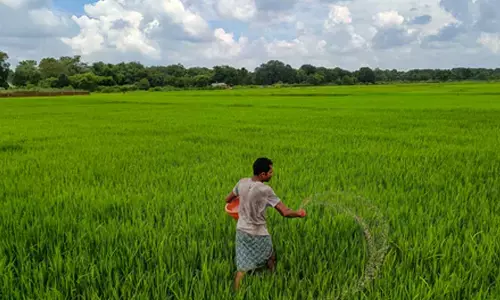India blind to harms of GM crops

While the debate about the toxic and harmful GM foods remains inconclusive, several countries have exempted gene-edited crops from the tougher regulatory regime as prescribed for GM crops. In England, the new Genetic Technology (Precision Breeding) Bill means that gene-tweaked crops can grow without being labelled. In India, the rules have also been relaxed for SDN1 and SDN2 types of gene-edited crops and micro-organisms. The tragedy is that while the international community talks of the urgency to move towards transforming the food systems, it ends up doing more of the same – encouraging GM crops to fix the broken food systems, not realising that GM crops have exacerbated industrial farming thereby adding to increased emissions
First, the good news! Kenya’s Court of Appeal has turned down the government’s application seeking lifting of the suspension ordered earlier by the High Court against import of Genetically Modified (GM) crops. The Attorney General had argued that the stay order had meant infringement of freedom and rights of Kenyans, who wanted to eat and trade
.
No merit in GM foods claims
Not finding any merit in the claims, the Court of Appeal turned down the move. This means that Kenya will not be importing GM crops and food till the High Court takes a final decision. This comes as a big relief to consumers and small farmers, who have been campaigning to get the Kenyan President William Ruto to reverse his decision to lift the 10-year ban on GM crops. Ostensibly taken under pressure from the powerful GM seed lobby, the President’s decision had evoked a strong reaction.
Turned down in Philippines too
A few weeks earlier, on April 18, the Philippine Supreme Court using the Writ of Kalikasan had come out against the commercialisation of genetically modified Golden Rice and Bt Brinjal, upholding the plea by a respectable farmer-led network, Masipag, which had warned that uncertainties associated with GMOs could cause irreparable damage to the ecosystem. It was heartening to find the Philippine Supreme Court valuing the principles of human rights.
Wikipedia explains that a Writ of Kalikasan is a legal remedy in the Philippine law, which provides for the protection of one’s right to “a balanced and healthful ecology in accord with the rhythm and harmony of nature,” as provided for in Section 16, Article II of the Philippine Constitution.
US pressures Mexico to lift ban on GM
And now, let’s talk of the uncomfortable moves. All this is happening at a time when Mexico is now faced with tremendous pressure from the US for lifting the ban it had imposed on importing GM crops. I thought it was a very courageous decision by the Mexican President Adres Manuel Lopez Obrador when he announced: “We do not want GM corn ... We are a free and sovereign country.” But eventually he came under pressure from the GM corn lobby in the US. As expected, the ban snowballed into a trade issue. It will now be interesting to see how long Mexico can resist the coercion.
US coming after Indian govt, too
Back home, India too is being pressurised by the US in the World Trade Organisation (WTO) to remove the restrictions on the import of GM rice and apples.
What worries me is that while the courts in Kenya and the Philippines realise the negative consequences of cultivating GM crops, the Indian regulator – Genetic Engineering Appraisal Committee (GEAC) – under the aegis of the Ministry of Environment, Forests and Climate Change, is merrily according approval to GM crops. In recent months, it first gave environment clearance for the low-yielding GM Mustard, which in my understanding should have been confined to the scientific dustbin, and is now reportedly close to allowing the commercialisation of Herbicide Tolerant (HT) cotton crop.
This only shows that contrary to growing public preference for non-GM and non-chemical foods, the GEAC is influenced by the claims of multinational seed companies.
Just to illustrate. In Madhya Pradesh, ever since the National Education Policy was launched, the number of students opting for organic agriculture has gone up tremendously. In 2022-23, around 86,263 students opted for organic farming, and another 9,038 opted for horticulture. This is indicative of an educational trend shifting towards safe and healthy foods. Even students realise where the future of agricultural research lies.
Regarding the demand for organic food, the Indian Organic Food Market Report shows that the organic market for food had already reached $1,278 million in 2020. By 2028, it is expected to cross $4,602 million. This shows an impressive compound annual growth rate of 23.8 per cent. With demand for organic food multiplying, and with emphasis on health and wellness increasing manifold, the need is to bring in appropriate agricultural and food policies that lead to environmentally safe agriculture that drastically reduces the ecological footprint.
On the contrary, I find often the hype that is created about climate-smart agriculture, which includes pushing GM crops and gene-edited crops, lures policy planners to ignore evidence-based research and performance. The tall claims being made about the success of Bt cotton crop clearly tells us that the policy makers, media and academicians were swayed by aggressive lobbying by GM companies.
At a time when the scientific community remains rather quiet, one has to admire Dr Keshav Kranthi, a former director of the Central Institute of Cotton Research, and now the Head, Technical Information Section at the US-based International Cotton Advisory Committee, for very clearly stating that the Bt cotton hype about increased productivity had more to do with increased area under irrigation and the huge increase in fertiliser use between 2002 to 2011.
Tragic reality
While the debate about the toxic and harmful GM foods remains inconclusive, several countries have exempted gene-edited crops from the tougher regulatory regime as prescribed for GM crops. In England, the new Genetic Technology (Precision Breeding) Bill means that gene-tweaked crops can grow without being labelled. In India, the rules have also been relaxed for SDN1 and SDN2 types of gene-edited crops and micro-organisms. The tragedy is that while the international community talks of the urgency to move towards transforming the food systems, it ends up doing more of the same – encouraging GM crops to fix the broken food systems, not realising that GM crops have exacerbated industrial farming thereby adding to increased emissions. Further, possible risks of genome-edited crops and the ‘unpredictable’ impact for human health and biodiversity have been simply ignored.
Nevertheless, returning back to Bt cotton, an interesting study makes a comparison between the cost of production, productivity and earnings from the cultivation of desi cotton with Bt cotton.
While the average yield of Bt cotton has been around 10.5 quintals per care, desi cotton yields nine quintals per acre. Interestingly, the net profit for farmers growing Bt cotton was Rs 36,917 per acre compared to Rs 36,017 per care for desi cotton. If the income for farmers is almost the same, I wonder why have the policy-makers been talking so high of the Bt technology. After all, what matters to farmers is the net income they earn from cultivating any crop.
Well, the answer is very simple. While the improved technology may not have made any significant increase in farmer’s income, it has certainly helped boost the profits of agribusiness companies. This has enabled food companies to dole out larger dividends to stock holders. The evidence is all there but only the policy makers, media and scientists refuse to see it.

















